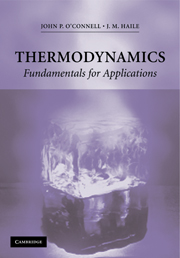Book contents
- Frontmatter
- Contents
- Preface
- Acknowledgments
- THERMODYNAMICS: Fundamental for Applications
- 0 Introduction
- PART I THE BASICS
- PART II SINGLE-PHASE SYSTEMS
- PART III MULTIPHASE AND REACTING SYSTEMS
- PART IV ENGINEERING CALCULATIONS
- 10 Options for Equilibrium Calculations
- 11 Elementary Computational Procedures
- 12 Selected Applications
- AFTERWORD
- APPENDICES
- Notation
- Index
11 - Elementary Computational Procedures
Published online by Cambridge University Press: 05 June 2012
- Frontmatter
- Contents
- Preface
- Acknowledgments
- THERMODYNAMICS: Fundamental for Applications
- 0 Introduction
- PART I THE BASICS
- PART II SINGLE-PHASE SYSTEMS
- PART III MULTIPHASE AND REACTING SYSTEMS
- PART IV ENGINEERING CALCULATIONS
- 10 Options for Equilibrium Calculations
- 11 Elementary Computational Procedures
- 12 Selected Applications
- AFTERWORD
- APPENDICES
- Notation
- Index
Summary
Multiphase systems and chemical reactions pervade the chemical processing industries. For example, we routinely force the creation of a new phase to exploit the accompanying change in composition; consequently, phase changes are used in many separation processes, including distillation, crystallization, and solvent extraction. In addition, we routinely suppress the creation of a new phase, for example, to maintain inventory of liquids by controlling loss due to evaporation and to meet health and safety standards by controlling evaporation of flammable, hazardous, and toxic substances. Likewise, we often promote chemical reactions to convert inexpensive raw materials into valuable products. But we also try to prevent other reactions that convert valuable materials into costly wastes, and we try to prevent reactions that convert benign substances into hazardous or toxic chemicals. In all such situations, the design and operation of appropriate processes may hinge upon computing proper solutions to phase-equilibrium problems or reaction-equilibrium problems or both.
In previous chapters we developed the thermodynamics of phase and reaction equilibria, and we illustrated certain principles using straight forward computational procedures. We used only simple procedures so as not to detract from thermodynamic issues. In this chapter we consider more complex situations and therefore give more attention to computational techniques. No new thermodynamics is introduced in this chapter; instead, we try to show how the thermodynamics already developed can be used in multicomponent phase and reaction-equilibrium situations.
- Type
- Chapter
- Information
- ThermodynamicsFundamentals for Applications, pp. 477 - 528Publisher: Cambridge University PressPrint publication year: 2005



